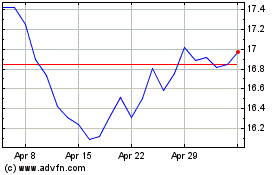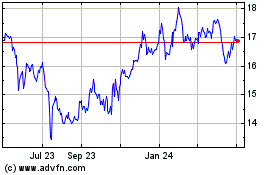By Drew FitzGerald
U.S. officials have told telecommunications executives around
the world to steer clear of Huawei Technologies Co., calling the
company a national-security threat, but that hasn't prevented
AT&T Inc. from using the Chinese company's equipment in
Mexico.
While AT&T has kept Chinese equipment out of its domestic
networks, industry executives say the U.S. company uses Huawei's
gear to run a large part of the wireless network in Mexico, where
the electronics giant is as welcome as any other supplier.
Huawei boxes sit atop cellphone towers across Mexico, where
AT&T is the No. 3 provider in terms of wireless subscribers.
The Dallas company inherited much of its Mexican gear through
acquisitions, though executives say it also has used the Chinese
supplier to upgrade its 4G network in recent years.
"We are the most significant vendor in this country," Cesar
Funes, a Huawei vice president in Mexico, said in an interview. "We
respect, of course, headquarters' discussions with their
governments. We just continue supplying them what we are asked to
supply."
An AT&T spokesman said U.S. officials haven't asked the
company to remove its Huawei gear in Mexico, though the carrier
already replaced some hardware at the heart of its cellphone
network for business reasons.
"When we upgraded our Mexico network to 4G LTE, we replaced
Huawei in our data core network with equipment from the same
suppliers we use in the United States, because it gave us
consistency in design and scale in purchasing," the spokesman said.
"We expect to harmonize our networks in the same way when we
upgrade to 5G in Mexico."
Huawei has won at least four wireless infrastructure contracts
since 2011 to enhance cellphone service for Mexican carriers,
according to industry research firm Ovum. They include half of the
machinery for Red Compartida, a new 4G network shared by several
companies that the Mexican government launched to spur
competition.
Mr. Funes declined to provide details about AT&T or other
clients, though he said his company runs more than half of the 4G
cellular gear in Mexico.
Huawei competes with Sweden's Ericsson AB and Nokia Corp. of
Finland to equip cellphone network operators. Most large telecom
companies keep two or more suppliers in the mix to maintain
leverage in future negotiations.
In January, the U.S. Justice Department unveiled criminal
charges against Huawei, accusing the company of stealing trade
secrets. Canadian authorities arrested the company's finance chief
at the request of U.S. prosecutors alleging the company violated
sanctions against Iran.
Huawei has repeatedly said it operates independently from the
Chinese government and its equipment is safe.
AT&T Chief Executive Randall Stephenson, when asked whether
he might use Huawei's technology to build the company's 5G network,
was unequivocal.
"Our government has told us not to, so I get it. We are not
using Huawei, " Mr. Stephenson said in March at an Economic Club of
Washington, D.C., luncheon, adding that U.S. officials are "very
aggressive on this, that this is a security risk."
Huawei's success in Mexico shows the uphill climb U.S. officials
face convincing private-sector leaders that the Shenzhen-based
telecom giant poses an imminent threat to their information
security. The State Department has stepped up its campaign in
recent months to persuade allied countries to avoid doing business
with Huawei, with limited success.
A State Department spokeswoman declined to comment on diplomats'
discussions with Mexican authorities. Department official Robert
Strayer said in a recent press conference the U.S. has "encouraged
countries to adopt risk-based security frameworks, and we think
that a rigorous application of those frameworks...will lead
inevitably to the banning of Huawei," as well as ZTE Corp., another
Chinese electronics maker.
Mr. Strayer also said 5G networks could face a greater risk from
insecure electronics than today's systems. Snooping on a wireless
network is considered easier at the "core" of today's 4G networks
than at the edges where cell towers communicate with individual
devices, but that could change as wireless technology evolves.
AT&T entered Mexico in late 2014 after the Mexican
government enacted legislation to enhance competition in a famously
concentrated telecom market. The Dallas company pieced together a
wireless company by snapping up two smaller players, Iusacell and
Nextel Mexico, inheriting a dense network of machinery bought from
Huawei, among other suppliers.
AT&T doubled down on Huawei over the next four years as it
upgraded the infrastructure it acquired to support 4G service. A
senior AT&T executive in 2016 told an industry publication that
the supplier's performance was "excellent." The company has
estimated the price of replacing the Huawei electronics it has in
Mexico and found the cost prohibitive, according to a person
familiar with the matter.
The Chinese company, which also makes cellphones, has spent
years raising its profile in Mexico. It had its brand name splashed
across jerseys for the popular soccer team Club América -- until
the AT&T logo took its place. When AT&T's Mexican
headquarters moved into a glassy tower finished in 2016, it asked
Huawei to add a satellite office a floor away.
"Huawei today is one of the main providers of infrastructure for
the Red Compartida, which is the biggest communications
infrastructure project in the country in the last five or 10
years," said Mony de Swaan, former head of Mexico's telecom
regulator, the Federal Telecommunications Institute.
AT&T has bet that a Mexican middle class can boost its
future profits. The company invested more than $7 billion,
including the $4.4 billion spent to acquire Nextel and Iusacell,
over the past four years to improve its network there.
The investments appear to have worked: AT&T ended 2018 with
more than 18 million wireless lines in Mexico, trailing billionaire
Carlos Slim's América Móvil SAB, which has 75 million, and Spain's
Telefónica SA. The U.S. company's executives say the business will
start turning a profit this year.
--Robbie Whelan contributed to this article.
Write to Drew FitzGerald at andrew.fitzgerald@wsj.com
(END) Dow Jones Newswires
April 16, 2019 05:44 ET (09:44 GMT)
Copyright (c) 2019 Dow Jones & Company, Inc.
AT&T (NYSE:T)
Historical Stock Chart
From Mar 2024 to Apr 2024

AT&T (NYSE:T)
Historical Stock Chart
From Apr 2023 to Apr 2024
